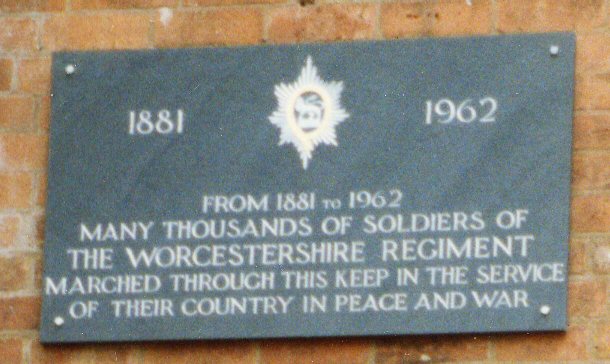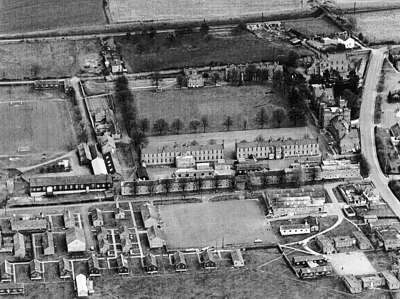Norton Barracks
A circular, dated 21st April 1873, contained a warrant, dated 8th April 1873, stating that her Majesty had sanctioned the formation of district brigades. The Worcestershire Militia, to which a 2nd Battalion was to be added, was brigaded with the 29th (Worcestershire) Regiment, the 36th (Herefordshire) Regiment, and the Herefordshire Militia; the whole forming the 22nd Brigade under Colonel Robert White, C. B., late 17th Lancers (Light Dragoons). New Barracks were to be built for the accommodation of the brigade depot at Norton, about three miles from Worcester.
In 1872 the War Department purchased the 20½ acres site for £3,500, and work on building the barracks was started in December 1874. By May 1877 the new Norton Barracks was completed and handed over to the Regiment. On the 17th December 1877, Captains Claremont and Cooper, Lieutenants Littledale and Ross, with Sergeant-Major T. Shattock, 4 Sergeants, 5 Corporals and 12 Privates, under the command of Major Berkeley, proceeded by train to Worcester, and then marched to the new Norton Barracks. These Barracks would now accommodate the depot companies of the 29th and 36th Regiments. To the Depot of each Regiment was assigned a block of buildings, over the doorway of which was painted the name of the officer who raised the particular regiment.
The barracks consisted of a gatehouse "Keep" with offices on one side and officers' quarters on the other side, two large barrack blocks for the accommodation of soldiers, cookhouse, and two married quarters blocks, and a hospital. The area was enclosed by a 10 ft. high wall. The estimated cost of the contract was around £65,000.
The "Keep" had underneath the entrance a large tank capable of holding some 20,000 gallons of water supplied by the City of Worcester. From this tank water was pumped by steam power into two cast iron tanks at the top of the "Keep", which supplied the whole barracks with water. The rest of the Keep was used for stores.
In the centre of the barracks was the parade ground with buildings all round it. The office block was built for the District Commander's H.Q., The Worcestershire Militia Battalion and Company H.Q's, engineers, paymaster and Depot companies of 29th and 36th Foot. At the end of the office block was the Sergeants' Mess, the men's canteen and reading room. The officers' quarters block provided accommodation for the Quartermaster, an Officers' Mess and single officers' quarters.
The two barrack blocks were two storeys high and consisted of four rooms, each to accommodate 28 soldiers, and a small room adjoining each barrack room for an N.C.O. Behind the barracks blocks was a cookhouse and bath-house. A drill shed was provided on the North side of the parade ground.
On the East side were two married quarters blocks providing accommodation for 31 married men and an infant school. Behind the married quarters blocks was a laundry with drying and ironing rooms. In the South-East corner was a hospital providing accommodation for 28 patients, surgery, kitchen and an isolation ward. Stabling was also provided for the horses.
To the North of the barracks and outside the wall was 9 acres for training and camping.
In November 1877, a party from the 36th Foot arrived as the Depot Company of the 36th Foot to prepare the barracks for occupation, then on 17th December, 1877, five Officers, one Warrant Officer, four Sergeants, five Corporals and twelve Privates arrived as the nucleus Depot Company of the 29th Foot. Each Depot Company was assigned a block of buildings, over the doorway of which was painted the name of the officer who raised the Regiment.
The building assigned to the Depot Company of the 29th was in error named "Albermarle" instead of "Farrington" as it should have been.
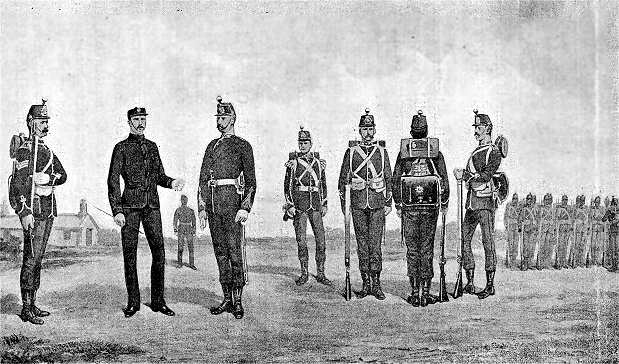
Group of Regiment in 1878 - by R. Simkin
Early in 1878 the H.Q. of 1st and 2nd Militia Battalions The Worcestershire Regiment were moved from their Regimental Depot in St. George's Square, Worcester, to Norton Barracks. On 20th April, 1878, the Militia Reserve was mobilized at Norton Barracks and 114 men left on 29th April to join the 36th Foot at Pembroke Dock where they remained until July. The two Militia Battalions assembled for annual training on 8th July, 1878, and were under canvas in the camping ground adjoining the barracks. The training of the Militia recruits (which consisted of 55 days preliminary drill) was carried out at Norton Barracks continuously throughout the year.
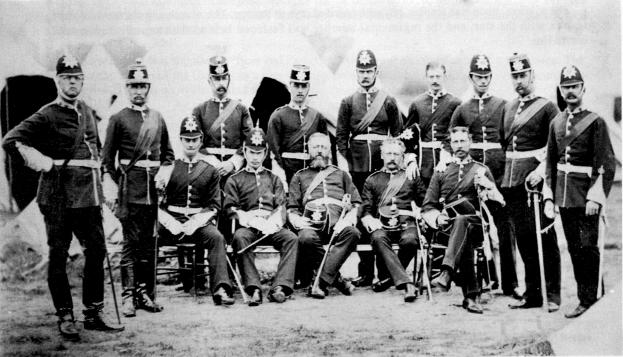
2nd Militia Battalion Officers at 1st Camp Norton Barracks (1878)
Stranding back L to R: Lieut.-Col. M. E. Vale, Major W. P. Howell, Capt. J. S. Kersteman, Lieut. M. H. Berkeley, Capt. W. H. Allsop,
Lieut. J. V. Colby, Lieut. R. Holden, Capt. H. Chillingsworth, Lieut. W. S. Clarke.
Front seated L to R: 2nd Lieut. M. R. Stubbs, unknown, Capt. T. Sheddon, Capt. O. C. Walcot, Capt. H. W. Domville.
On the 1st July 1881 the infantry of the line, and militia, formed territorial regiments, each of four battalions, for England; the 1st and 2nd being line battalions, the remainder militia. The words "Regimental District" was substituted for "Sub-District". So it was that the 29th "Worcester" regimental district, were allotted the 29th (or the Worcestershire) Regiment, the 36th (Herefordshire), and two battalions of the Worcestershire Militia. These four battalions now formed "The Worcestershire Regiment", the uniform of which was ordered to be scarlet, with white facings, and rose pattern lace. The officers, non-commissioned officers, men of the 3rd and 4th Militia Battalions were directed to wear the letter "M" on their shoulder straps.
In 1882 the two administrative Battalions of the Volunteer Corps became 1st and 2nd Volunteer Battalions The Worcestershire Regiment in.
On 28th June, 1886, 3rd Militia Battalion The Worcestershire Regiment was at the barracks presented with new colours by the Countess Beauchamp, wife of the Lord Lieutenant of the County.
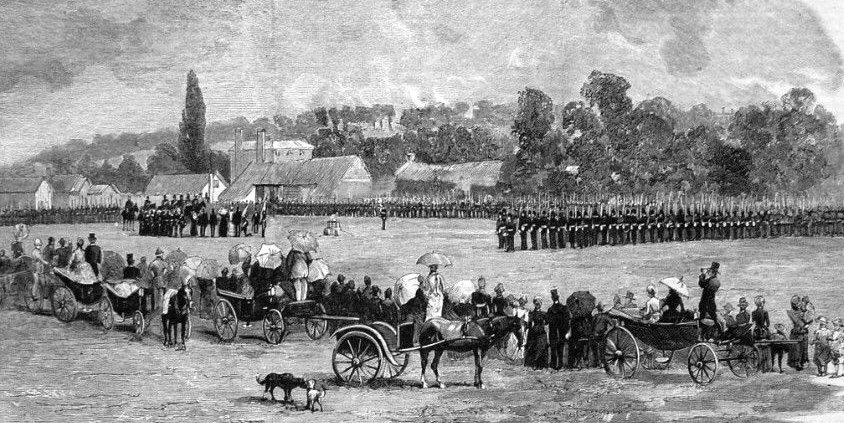
Presentation of New Colours to the
3rd Militia Battalion The Worcestershire Regiment by Countess Beauchamp (28th June 1886)
The training of the Regular and Militia recruits went on side by side until 1900. In 1900 as recruiting was good, The Worcestershire Regiment was ordered to raise two new Regular Battalions which were numbered 3rd and 4th and as a result the Militia Battalions were re-numbered 5th and 6th Battalions. The Depot was now short of accommodation for the number of recruits under training and two new blocks were built behind the two existing ones. The rooms were much smaller than in the original two blocks, holding ten men to a room. They were later named Higginson and Jacob blocks after two very distinguished Colonels of the Regiment. At the same time a mobilization store, gymnasium and Sergeants' Mess were built on the North of the parade ground.
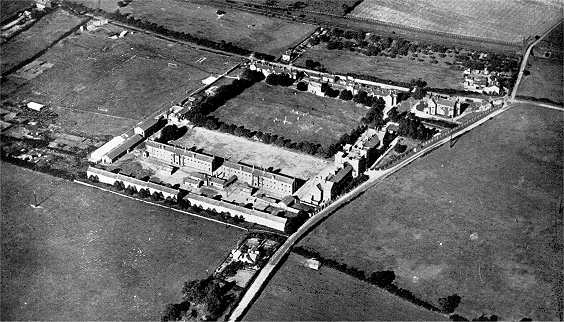
Norton Barracks in 1930
In 1907 there was a further change in the establishment when the two Volunteer Battalions were reorganised into the 7th and 8th Battalions The Worcestershire Regiment of the Territorial Force. The 7th Battalion had their H.Q. in Kidderminster while the 8th Battalion H.Q. was at 16 Silver Street, Worcester. The Depot continued to feed the home Battalions of the Regiment with trained soldiers and also to hold the mobilization stores for all reservists.
On the outbreak of 1914/18 War the 5th and 6th Militia Battalions mobilized and moved to the Plymouth area where they acted as a holding unit and carried out re-training of officers and men who had recovered from their wounds.
The Depot mobilized the reservists and sent them to the 2nd and 3rd Battalions at Aldershot and Tidworth respectively. The Depot expanded and continued the training of recruits throughout the War.
In 1922 The Worcestershire Regiment was reduced to two Regular and two T.A. Battalions. The Depot trained recruits for the home Battalion as well as giving valuable assistance to all School C.C.F's in the County and also Cheltenham College.
In 1939 the function of the Depot was still to train recruits and administer the regimental home. Early in 1940 a principle was established by which training divided into “Primary” training, covering the first six weeks of service, and “Corps” training, which concentrated on the more advanced training for infantry as such. To meet requirements the 23rd Infantry Training Centre (I.T.C.) was set up at Norton with two Primary Training Companies and two Corps Training Companies, the old Depot dwindling to a small Depot party and reduced to a strength of four officers and a few other ranks. Initially the number swarming into the barracks was so great that the old Jam factory (now Morgan Crucible) was requisitioned and a hutted camp built which included large Officers' and Sergeants' Messes, two O.R's cookhouses, two parade grounds and M.T. garages. At the end of the War an American unit moved into the hutted camp while the old Depot continued under the title of 29 P.T.C. (Primary Training Company). In July, 1946, orders were received for the Corps Training Companies and Headquarters to move to Oswestry to establish a new Infantry Training Centre. But a Primary Training Wing of two companies was left behind at Norton to be administered by No. 20 Holding Battalion, which had just arrived. |
Norton Barracks in 1945 |
On arrival at Oswestry four companies were formed to represent the four regiments of the I.T.C., and these were respectively No. 1 (Cheshire), No. 2 (Worcester-shire), No. 3 (South Staffordshire) and No. 4 (North Staffordshire). The new I.T.C. was now known as the West-Midland I.T.C., and was shortly afterwards redesignated “The Mercian Brigade Training Centre.” At Norton in the meanwhile No. 20 Holding Battalion had been disbanded, and on 28th November, 1946, No. 29 Primary Training Centre (P.T.C.) was formed under the command of Lieut.-Colonel L. G. H. Bryant with two Primary Training Companies.
Throughout these changes the Regimental Depot party had continued to function. Not the least of its duties was to guard jealously the interests of the Regiment in the face of many minor problems raised by officers in authority who had only a passing interest in Norton Barracks as the permanent regimental home. In addition, it was, of course, responsible for the permanent records and administration of all matters pertaining to the Regiment.
Administrative changes followed thick and fast. In January, 1948, the Mercian Brigade I.T.C. moved from Oswestry to Lichfield. Thus at this stage personnel trained in the P.T.C. at Norton due for the Worcestershire Regiment completed their training at Lichfield. A further change was effected when the four-company organization which had functioned at Oswestry gave way to the existing arrangements by which one Regular battalion of the Mercian Brigade Group became the recognized centre for training all personnel selected for regiments of the Mercian Brigade from the various P.T.Cs. Battalions of the group now take it in turn to function as “the Mercian Brigade Training Battalion,” to which is attached a Group Training Centre with a small administrative Staff. The background to these changes was clearly and convincingly set out in a letter of June, 1948, from the Colonel of the Regiment, Brigadier B. C. S. Clarke, to all officers:
“An even greater change is the introduction of the group system by which regiments are brigaded together in county Groups. It was found to some extent in the 1914-18 war, but very much more so in the recent war, that more often than not it became impossible to post reinforcements to their own regiments. As an alternative to a Corps of Infantry it is thought that by confining such postings within brigades much of the regimental spirit may live again within the brigade group. We have been grouped with the Cheshire, North and South Staffordshire Regiments under the name of the Mercian Brigade. Unwelcome as these changes undoubtedly are, it must be admitted that it is difficult to find a practical alternative, and officers and men may now be called to serve in any regiment of the group.”
In April, 1948, it was decided that all personnel, both Regular and National Service, should undergo “basic” training, as primary training was now designated, with their own arm of the service. P.T.Cs. were therefore disbanded. Thus a recruit for the Regiment now joins at Lichfield.
The conditions of modern war demand that personnel be available for posting over a far wider field than previously obtained. A modern recruiting system has to be both fluid and flexible; and in fulfilling these requirements the old personal attachment and interest of a recruit for the regiment of his choice must to some extent be sacrificed in general administrative interests. The Regiment has taken these changes with calm resignation; and it is some slight compensation that in April, 1948, the Depot Staff was increased to four officers and twenty-two other ranks with a clear-cut function as the custodian of all regimental property and with general responsibility for the regimental home. The new functions of a Depot. were defined as to act as the Headquarters of the Regiment, to provide administrative facilities for Territorial Army and Cadet training, and to hold various categories 1 of personnel. Simultaneously with the Depot increase in establishment, the appointment of an Administrative Officer was recognized, a serving Captain or retired officer being eligible. Thus it was that Norton Barracks was able to welcome back Colonel S. W. Jones, who has assumed control of many matters of regimental administration outside the sphere of normal Depot responsibility. The duties of an Administrative Officer are varied and manifold, and must vary greatly according to conditions in different regiments.
It was with the object of ensuring that subsequent to the infantry reorganization in June, 1948, the full weight of preserving the regimental home should not fall on the small Regimental Depot that the Colonel of the Regiment issued an appeal to all officers, past and present. In particular, attention was drawn to the difficulty of maintaining the Officers’ Mess, a difficulty accentuated when officers of the Depot lived out. The appeal covered proposals for an annual subscription from all officers. As a result the Regiment still had its own Mess at Norton Barracks, which was a gathering place from time to time for numbers of officers, past and present. In the same way the Sergeants’ Mess was also made a Regimental Mess, fulfilling the same function for past and present members of the various Sergeants’ Messes of the Regiment.
The recent establishment of the Regimental Room at Norton was a happy way of realizing the need to provide a room for present and past other ranks of the Regiment to meet and use as a home. It was furnished and decorated with pictures and trophies and readily combined the pleasant atmosphere of a club and a home.
The above is but a recital of the bare bones of drab administrative matters. Behind the facts are many small episodes of human interest which must be left to the ready imagination of all with experience of the “correct channels” of military administration.
Before passing to other matters of regimental concern, a record should be made of an association of interest which logically can have no particular claim to any definite point in Regimental History either in time or location. After World War I two Australian units, the 29th and 36th Australian Infantry Battalions, were appropriately allied to the Regiment, the former stationed in East Melbourne, the latter in Haberfield. There was unfortunately never an opportunity to translate the association into more than an alliance on paper, and on the reorganization of the Australian land forces after World War II these battalions were not re-raised.
In describing the high-lights of work or play an attempt has been made to touch on those achievements which merit a record as they occur in the lives of the battalions of the Regiment. But there is one aspect of play which is particularly associated with Norton Barracks and which therefore seems to demand a separate reference ; for cricket is a game which has flourished from an encouragement and interest directed from the Depot in a manner which does not apply in the case of the other methods of chasing a ball or in athletics. It is natural that it should be so, for not only are the hopes of a great home of county cricket centred round a well-known setting down by the River Severn within the city of Worcester, but also the shady seclusion of the green field within the Barracks has come to be regarded as the appropriate home of a regiment which reflects the devotion of its county to the great game.
After World War I the annual cricket week was held during mid-July. Cricket waned during World War II, to be revived in 1946, and since 1947 the week has been held during the last week in June.
Arrangements for the week of four days’ cricket have always been the prerogative of the Officer Commanding the Depot and his staff. If team-building proved the major problem before the war, more than. ever is it a headache in modern times when, without a Regular battalion at home, and with the Territorial battalion occupied in building up its strength, the services of officers and other ranks who have left the Regiment have been sought and exploited: and very readily they have responded to the call.
The machinery for assembling the regimental team has to be put into operation as early as March, and after much correspondence and many frantic telephone calls the team is ready to take the field at the end of June. An air of relief then pervades the Depot orderly room. Over the years a number of friendly foes have afforded annual fixtures. “The Worcestershire Gentlemen,” “Hereford Gentlemen,” “Shropshire Gentlemen” and “Warwick-shire Imps,” all well-known clubs in the Midlands, have been welcome visitors with whom many exciting finishes have been fought out. In 1925 at Worcester and 1926 at Aldershot matches were played against “our cousins,” the Royal Lincolnshire Regiment. Unfortunately, there then ensued a long gap; but in 1947 the contest was revived and has now been an annual fixture, being played alternate years at Lincoln and Worcester. The honours are so far equal, “our cousins” being victorious in 1948 and 1950, and the Regiment winning through in 1947 and 1949. Of the many performers with both bat and ball who might claim distinction, the name of Lieut.-Colonel A. C. Johnston DSO as a batsman during the period 1922-1939 will not be forgotten. His sterling efforts on many occasions in defeat or victory were an example always for the young entry. In recent years it is not too much to say that the enthusiastic direction of Lieut.-Colonel L. G. H. Bryant has been mainly responsible for the effective revival of regimental cricket. And so amid many difficulties and with absences through service abroad the game goes on. May it always be so!
Veterans of World War I must view with some bewilderment the many modifications and changes in dress which have been adopted by the infantry of the British Army in recent years. In 1922 officers were still wearing khaki breeches, puttees, and laced leggings. In 1925 dismounted officers took to plus-fours. In 1937 mounted officers gave up leggings and took to the “gunner-boot” with three straps. But with the passing of the horse and the need for a practical dress to stand up to all conditions, the Army as a whole went into battledress shortly before the outbreak of war in 1939. At the same time another sign of the times was the passing of mess dress, a new blue uniform being introduced which is to take the place of mess dress, blue patrol or full dress. The changes in head-dress have been more erratic. Between the wars a green and blue forage cap was introduced, Field Officers being distinguished by gold piping. When battledress appeared this gave way to its khaki counterpart, known officially as the “F.S. cap.” This in turn was found unsuitable and a khaki beret in imitation of the Royal Tank Corps was adopted, which was later changed to the present dark blue beret. It was on the orders of the G.O.C., 43rd (Wessex) Division, that before embarking for Normandy his units took to a coloured backing to the badge on the beret, and thus it was that the 1st Battalion assumed the green backing for the first time at home in April, 1944, with the approval of the Regiment. A green backing to the badge on the topee had, of course, been worn in India for many years.
So far as the Regiment were concerned, interest was not so much in the general changes as with the more personal small problems of badges, facings, buttons and ties. Between the wars facings on the full-dress tunic changed from white to green, and it is on record that at a Levee at St. James’s Palace on “The Glorious First of June” in 1931, twenty-seven officers of the 1st Battalion were presented by Field-Marshal Sir Claud Jacob, on their return from foreign service, in the new uniform. Captain H. FitzM. Stacke, in his History of the Regiment, has referred to the efforts which were made after World War I to return to the traditional elongated star of the Garter as a cap-badge. An unimpressive round bronze badge with a scroll had crept into use, and it took a Regimental Committee three years to effect a return to the old eight-pointed star in silver, the removal of the scroll allowing for the lengthened shape to be reintroduced. In 1930 an effort was made to standardize the dress of officers as between the two Regular battalions. The 1st Battalion, for example, had been wearing no stars on the collar in blue patrol. Thus if an officer from the 2nd Battalion transferred to the 1st Battalion his collar displayed two empty holes where formerly stars had appeared. The 2nd Battalion wore two buttons on the cuff of their khaki jacket. The 1st Battalion did not. These and other anomalies were rectified by a Regimental Committee. It remains only to collect a few reflections on some institutions and aspects of regimental life and place them on record for future generations.
The life of a battalion is the story of its movements from A to B, the battles in which it has been engaged, its reactions to Plymouth, Malta, Shanghai or Aldershot. But the story of a regiment embraces many activities in England which in the case of the Worcestershire Regiment are followed with intense and constructive criticism by all ranks. It is to satisfy this vital enthusiasm of the Regiment as a family in which both serving and retired personnel have a stake that comment on a few features of common interest is added.
Such agencies as Firm, the Old Comrades Association, and the Museum at Norton are symbols of a vitality which will endure into the days when warfare becomes a matter for the science laboratories. Even so men will surely always have the last word.
Perhaps the first tribute should be to Firm, without which it would indeed have been difficult to write this story. In November, 1922, the 2nd Battalion started a journal, The Green ‘Un. The first editor was Lieutenant E. H. Knott, of the Army Educational Corps, and the Commanding Officer at the time received a letter of encouragement and congratulation from the Colonel of the Regiment, General Sir George Higginson.
It seems curious to record that the necessity for a magazine to cover the activities of all battalions and the Regiment as a whole had not made itself felt previously. The need was not met until 1927, when the first issue of Firm appeared in November of that year. It happily coincided with the appointment of Field-Marshal Sir Claud Jacob as Colonel. It was perhaps not so much a case of the need for a Regimental Magazine not being appreciated as the practical difficulty of finding an editor with the necessary time and capacity to give to the work. For the first issue, Captain Crawford, a retired officer, volunteered to make a start. But his work in civilian life assumed such dimensions that he was unable to spare the time for a second number. Thus it was that a whole year passed before the second copy of Firm appeared in November, 1928. From that month onwards the Regimental Magazine has appeared regularly as a quarterly except for the duration of World War II. Even so, under various editors and in spite of paper shortage, it struggled on until May, 1941. There was then a gap until November, 1945. From the point of view of an author searching for material for a History, the issues during the war were of limited value since the demands of the censor meant the elimination of all names, dates and places even though it might be only a matter of an inter-company game of football.
Subscriptions were maintained during the war years, and the first “peace” edition emerged in no way inferior to the pre-war standard. The annual subscription has remained at five shillings. Since its inception the printing of the magazine has been in the capable hands of the Messenger Company in Bromsgrove, who have produced a quality of print and paper of the highest standard. The form of the layout has not materially altered since 1927, with an Editorial, sections for Battalion and Company notes, notes on sport and individual contributions. The editor has rightly felt that contributions are not so much to be judged by their literary infallibility as by the manner in which they reflect the life of the Regiment.
The present editor, Colonel S. W. Jones, took over from Major Pereira in October, 1948, and in his hands the Regimental Magazine continues to constitute the link by which all members of the Regiment, past and present, are enabled to keep in touch with each other and with the movements of the Regular Battalion in its adventures abroad.
No mention of Firm would be complete without a reference to Major H. FitzM. Stacke for the labour and interest he continually gave to the magazine. His series of articles describing the actions which won Victoria Crosses for the Regiment were only one of his welcome contributions of research into past history.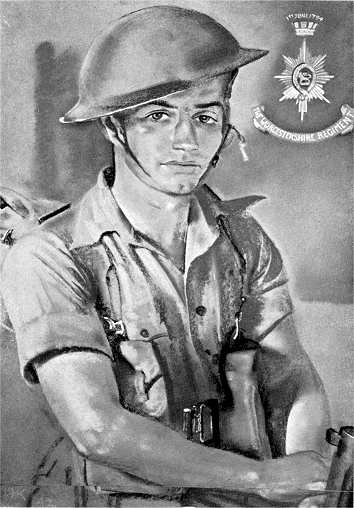
Bound copies of Firm are kept in the Regimental Museum: and it is to the Museum that we turn for a very complete supplement to the Regimental Magazine in the study of history. To a layman the scope of the Museum and the care with which it is maintained come as something of a surprise: and if an outside comment were permitted it might be to the effect that such an institution lies so far from the centre of the city of Worcester, whose citizens should share facilities to view those many exhibits connected with the history of a Regiment which to a real degree is their proud possession. The Museum is, of course, open to the public, and a new Worcester Guide Book is to draw attention to it.
From such a wealth of material, it is difficult to pick out relics of particular interest. Exhibits range from an officer’s sash of the 29th dating from the American War of Independence to the 75 mm. mountain gun captured at Maram Spur in Burma by the 7th Battalion in 1944. This, together with other Japanese weapons, was brought home by C.S.M. J. J. White, of Kidderminster, in the face of much opposition from Railway Transport Officers and Embarkation Staffs.
The portraits include Eric Kennington’s splendid pastel work of Private Hunt, D.C.M. (5251421) - shown here on the right - , of the 1st Battalion, and J. P. Beadle’s action picture of Gheluvelt. There is also a fine work by Matania of the battle of Neuve Chapelle. The artist is, of course, known for his vivid illustrations in the Sphere over a number of years. There is Sir Hubert Rance’s flag flown by him as Governor of Burma, an emblem of British authority which will presumably never fly again. There is the Nazi flag captured by the 8th Battalion in France and a khidmatgar’s belt to commemorate the association of the 2nd Battalion with the 6th Gurkha Rifles from 1942 to 1946. Perhaps one of the most striking exhibits is the bronze statuette, “The Sentry,” - shown below - by the late C. S. Jagger, who served with the Worcestershire Regiment in World War I and who used men of the Regiment as his models. “The Sentry” is a replica of his War Memorial at Paddington Station. His more familiar work is the impressive artillery memorial at Hyde Park Corner. These are but a few of the 1,400 exhibits which cover every phase of the life of the Regiment from the days of Farrington until 1950. Finally there is an excellent display of medals.
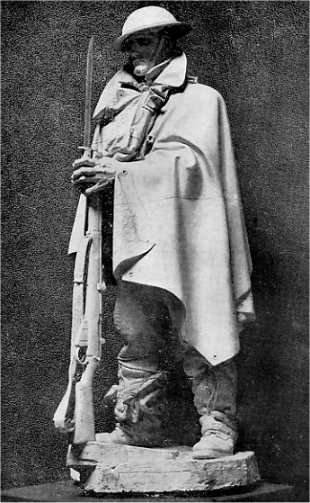 The Museum was started in the Depot Mess in embryo in 1933, and once again Major Stacke was responsible for its initiation, some badges and other relics left to the Officers’ Mess by the late Colonel Everard being used as the nucleus of the collection. It was first housed in the Officers’ Mess.
The Museum was started in the Depot Mess in embryo in 1933, and once again Major Stacke was responsible for its initiation, some badges and other relics left to the Officers’ Mess by the late Colonel Everard being used as the nucleus of the collection. It was first housed in the Officers’ Mess.
It is, however, Major H. P. E. Pereira whom we must thank for its subsequent expansion and layout; and it was he who managed its affairs from 1944 to 1948, when he left to take up an important appointment as curator of the Scottish United Services Museum at Edinburgh.
In 1935 the Museum moved to the Keep. During the war it was housed in temporary hutments outside the Depot. But since the war it transferred to the top floor in Farrington block, where there was space to display exhibits in a manner in which they can be studied without that bewilderment which results when trophies are heaped together in close confusion.
Until April, 1950, it was under the careful eye of Mr. Frank Lester, who as the guardian of so much history and tradition became known to many hundreds of the Regiment, past and present.
It was a tragedy that such a faithful servant of the Regiment was to be denied the experience of the reunion of April, 1950, for he died on 14th April, 1950, after an illness which he had faced with great courage and of which few were aware. Mr. Lester joined the Regiment in 1892, being posted to the 2nd Battalion on The Curragh in Ireland. After seeing service in South Africa and France he was wounded in November, 1918, and after a long period in hospital came to live in a regimental cottage outside Norton Barracks in 1926, taking charge of the Museum in 1935 when it was moved to the Keep. He was buried with full military honours at Norton churchyard, and it is good to know that a memorial in the Museum he loved so much will serve to remind future generations of a great servant of the Regiment.
After the Second World War, the work of the Worcestershire Regiment’s Association continues to play a vital part in the welfare and resettlement of all who have ever served with the Regiment, wherever they may be and whenever they are in need. It has been questioned whether in an era of National Insurance in a welfare state there is still scope for the work of a Regimental Association. The figures leave no room for doubt. In 1949 there were 521 applications for all types of assistance and advice, of which 399 were met. Grants and loans totalled £2,300. In distributing relief it is emphasized that the object is always to assist good men in the fundamental belief that God helps those who help themselves. The Association is, in fact, not merely a Society for dispensing charity.
Charles Sargeant Jagger, M.C.
On the outbreak of the Great War, in 1914, Charles Sargeant Jagger (born 1885), then a young sculptor studying in London and Rome, joined the Artists Rifles, from whence he was appointed to a commission in the Worcestershire Regiment. He served with the 4th Battalion in Gallipoli, where he was wounded, and afterwards with the 2nd Battalion in France and Flanders. In April, 1918, be commanded “D” Company of that Battalion during the defence of Neuve Eglise, and fought with great gallantry, stopping the enemy’s advance and successfully bringing the remnants of his Company out of action after the troops on his right and left had been overwhelmed. He was again wounded in that battle, and his bravery was rewarded with the Military Cross.
After the War he resumed his artistic career, and was recognised as one of the foremost of British sculptors. His best known work is the great memorial to the Royal Artillery erected at Hyde Park Corner in London. Another example of his Art is the Great Western Railway memorial at Paddington. In addition he is represented at the Tate Gallery by a notable bas-relief, and his “Nymph and Faun” group was one of the most prominent exhibits at the Royal Academy in 1952.
On 1st September, 1949, the Association which formerly was universally known as the Worcestershire Regiment’s Old Comrades Association changed to its present designation. In a letter the President, Lieut.-Colonel Sir John Reddie, set out the reasons for the change. The old title, it seemed, was unpopular with the younger members who associated it with the veterans of the South African War! Sir John Reddie stressed that a change in the title involved no change in policy; and welfare, resettlement and comradeship continue to be the concern of the Association. Nevertheless, in spite of an official new name, old habits linger on, and the words “Old Comrades” are frequently in use in moments of forgetfulness ! The offices of the Association are at 5, Foregate Street, Worcester.
A link which might in other circumstances have developed for the benefit of future generations of the Regiment is that which exists between the Regiment and three battalions of local cadets. They totalled about 700, the object being to prepare youth for national service. But apart from the wearing of the Regimental cap-badge by cadets, the link is a slender one. Cadets pass on to the Mercian Brigade and any domestic interest which might have developed is lost in vaguer claims on their loyalty.
Norton Barracks has been the scene of many ceremonial parades, symbols often of milestones in the regimental life. Indeed, the author’s first introduction to Norton in September, 1949, is coloured by a memory of the band of the Coldstream Guards, who were in Worcester for recruiting purposes, marching and counter-marching in full dress in front of Charlemont Block facing the Green. Here, only those prominent occasions are recalled which mark the more vital stages of constant regimental evolution.
The delivery up of the Colours of the 1st Battalion from the Cathedral in Worcester on 20th February, 1946, is perhaps an outstanding ceremony of recent times. For it marked an occasion on which the county of Worcestershire was able to express its gratitude and affection not only for the Battalion but for the Regiment which bore its name.
A special altar had been set up at the foot of the choir steps. At three o’clock in the afternoon the procession of the choir and Cathedral clergy made its way slowly from the Regimental Chapel of St. George to the altar. To the words of the 98th Psalm the brilliant splash of colour moved through the Cathedral and the Colours were laid on the altar.
At the time the Battalion was in Germany and so the Colours were taken over by a detachment of officers and men who had come to claim them. In solemn terms the Dean handed over the Colours and was in turn thanked by the Commanding Officer, Lieut.-Colonel C. P. G. Wills. The lesson was read by the Colonel of the Regiment, and a roll of drums heralded the National Anthem. There followed the Blessing. The Colour party rose and, to the Regimental Slow March, the Colours were marched down the aisle to the west door. There were many that day in the congregation who had shared the hopes and tragedies of Keren and Tobruk, who had known the comradeship of prison camps and who fought from Normandy into Germany. These men will have sensed that queer elation at the sight of the symbol of so much diverse heroism in distant lands, in the great Cathedral Church of their home town.
Outside, the people of Worcester had their opportunity to pay their tribute as the Colours were taken to the Drill Hall in Silver Street, there to be cased before being flown to Germany.
To the Dean of Worcester there is a debt of gratitude for the care he had lavished on a ceremony which in every detail reflected his purpose to complete a labour of love. Over a year later, on 16th July, 1947, Norton was the scene of another ceremony. Though without the impressive background of the Cathedral to mark the occasion, the laying-up of the Colours of the 2nd Battalion at Norton was a ceremonial parade of simplicity and sadness. The Battalion cadre under Lieut.-Colonel F. S. Ramsay were there to represent the officers and men who had so recently rung down the curtain on their last act in Burma. From Lieut.-.Colonel Ramsay, the Depot Commander, Lieut.-Colonel Bryant accepted the Colours for custody to be laid up in the Officers’ Mess until such a time as the 2nd Battalion are again called upon to uphold traditions which date from the year 1701.
Both escorts turned out in a manner worthy of the occasion, and the Colonel of the Regiment, who addressed the parade, was quick to comment on their high standard of drill. For him the parade was of personal appeal and significance.
Two months later the 2nd Battalion were again to remind us of their continuing identity. This time the ceremony was in London at the Royal Hospital, Chelsea. The Colours of certain regiments had for long been in the custody of the Governor of the Royal Hospital, and by command of the King they were returned to their units. In the case of the 2nd Battalion The Worcestershire Regiment the Colours had been presented on 10th November, 1816, at Portsmouth, on the anniversary of the battle of Nivelle. The Royal Hospital is an ideal setting for such an occasion, even though the scars of enemy action were still in evidence. The Colonel of the Regiment received the Colours, the King’s Colour being handed over by Pensioner G. C. Murphy, D.C.M., who had joined the Army in 1882, coming to the 1st Battalion at Aden in 1896.
Another pensioner, Private W. Lamb, who bad joined the 1st Battalion in 1886, was a witness at the ceremony, and the gathering of members of the Regiment included Lieut.-Colonels Watkins, Court, and Ramsay.
The Colours, faded and threadbare, now hang in the Regimental Museum. Their material lustre has vanished.
Yet their worn fabric tells a story of deeper significance than any later brilliance.
At some point the historian is faced with the choice of a date on which to close the present record of a great regiment: and in the present case there can be little doubt that 15th April, 1950, is as certain a landmark as would be found within the day-to-day events which comprise regimental history. The 1st Battalion were recently back from Germany and the opportunity was taken to concentrate several functions in one memorable day, a task which must have taxed the patience and capacity of the entire Depot Staff to the full. They rose nobly to the occasion and the day passed only too quickly for those hundreds of old comrades who had gathered from all corners of England to witness the parade on the county cricket ground, the ceremony in the Cathedral, and finally to dip into memories of the past for an hour or so in a great family gathering at Norton Barracks.
The afternoon opened with the presentation of silver drums to the Regiment by the Mayor (Alderman T. S. Bennett), coupled with the official grant of free entry to the city. The latter privilege was set out in a finely phrased resolution which was subsequently read out by the Town Clerk.
For an hour previously crowds had been gathering on the cricket ground. Fortunately, those responsible for arrangements were rewarded by the behaviour of the weather. In spite of ominous clouds the rain held off, while we were rewarded by the appearance of the sun at a moment when it was needed to lend that extra touch of warm colour which gave the ceremony a rich splendour rare in the modern days of drab mechanized ceremonial. Before the arrival of the Colours of the 1st, 2nd and 7th Battalions with the escort, furnished by the 1st Battalion, the band of the Cheshire Regiment entertained the spectators with light music, and for those privileged to witness the ceremony from the cricket pavilion the arrival of the Mayor and Corporation in full regalia was a spectacular diversion. Indeed, it is no reflection on subsequent events to say that the hat of the gentleman carrying the Mayor’s sword of state was a constant source of astonishment for the more privileged spectators. It might well have been lent for the occasion by the White Queen in “Alice in Wonderland.”
Punctually at 2.30 p.m. the Battalion, under command of Lieut.-Colonel A. H. Gillmore, O.B.E., and Colour parties marched on to the ground, led by the Band and Drums in full dress. In his inspection the Mayor was accompanied by the retiring Colonel of the Regiment, his predecessor, Brigadier-General Grogan, and his successor, Lieut.-General Gale. Following the inspection, the Mayor addressed the assembled company in a happy speech of acknowledgement of the city of Worcester’s appreciation of the great services of their county regiment in two World Wars. There was a brief summary of the great heritage of two and a half centuries and a sober reference to the grim demands of the international situation of today.
In reply Brigadier Clarke thanked the Mayor for the city’s magnificent presentation, adding that the drums would serve as a reminder of the warm interest for the comfort and welfare of the men of the Regiment displayed by the city and county throughout long years of war.
But to the casual spectator more significant than the details of a carefully-planned ceremonial was the spectacle of a new generation of the Worcestershire on parade receiving the tribute of their people in as fair a setting as could be found. It was indeed a happy gesture of the sun to shine out on a foreground of khaki and colour on the green field, yet catch the mellow stone of the great Cathedral which provided so glorious a background.
There followed a march through the town and some 2,000 Old Comrades fell in behind the Escort to the Colours and marched through crowded streets, the Mayor taking the salute in front of the Guildhall. Previously on the cricket field a voice which sometimes coaxed and sometimes threatened had had some difficulty in assembling a mildly difficult and light-hearted parade. But once on the road behind a band, to the strains of the march they knew so well, the Old Comrades shed the years and were for a few minutes again the men of former ceremonies of bygone days. In the new order, how welcome it is sometimes to be reminded that a city, a county and its regiment are still one!
The parade marched on into the Cathedral, where the scene was laid for the unveiling of the Regimental War Memorial in St. George’s Chapel and its dedication by the Bishop.
Great care had been taken to frame an impressive service covering the unveiling and dedication of the Memorial. After hymns and prayers the Colour parties which had taken post at the west end of the Cathedral moved to the Regimental Slow March up the nave to the Chapel entrance in the North Choir transept. Inside the Chapel the Colonel of the Regiment, after a short address, unveiled the Memorial, the Dean accepting it on behalf of the Cathedral and the Bishop adding his dedication. Brigadier Clarke briefly outlined the circumstances in which no less than a total of 579 officers and 10,308 (see note 1 below) other ranks had given their lives for their country in two world wars, and added that in remembering them others also who had suffered grievous bodily harm should not be forgotten. There followed the “Last Post” and “Reveille,” and a memorable service closed with “Abide with Me,” while finally the Colours, now at the choir steps, were lowered to the National Anthem.
The Memorial is simple but impressive in Hopton Wood stone of a light greyish-pink colour. It is surmounted by the Regimental Badge embossed and the Naval Crown and Irish Harp are at the base.
After the service there was a move to Norton Barracks, where tea was ready in a tent large enough to accommodate a circus. Here many old friendships were drawn out of their “cold storage” and experiences over the years exchanged. The outgoing and incoming Colonels of the Regiment made short speeches and, generally helped by beer, this happy reunion proved a great family party when many old friends could at last find out how fate had dealt with him or her since those more leisured days when friendships were not made in a hurry. “Those were the days” was indeed the background to the many memories refreshed on 15th April 1950.
Note 1: World War I: Officers 505, other ranks 9,463; World War II: Officers 74, other ranks
845.
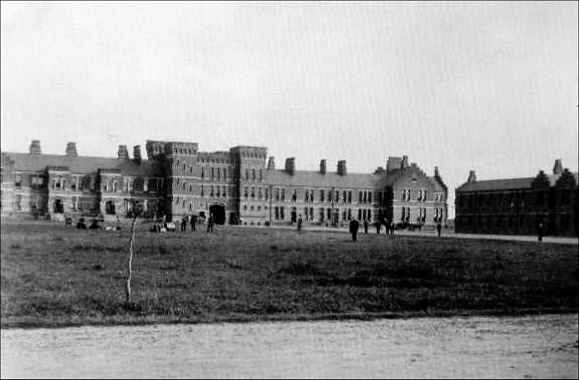
Norton Barracks in 1955
In 1951 General Sir Richard Gale, KBE, CB, DSO, MC, while Director General of Military training re-introduced Regimental Depot training in 1951. This system continued in the old part of the barracks until 1959 when the training of all recruits for the Mercian Brigade was transferred at Lichfield.
In early 1960 a plaque was placed on the entrance to the Keep to commemorate the years of the Depot. The wording reads:
FROM 1881 TO 1959 MANY THOUSANDS
OF SOLDIERS OF THE WORCESTERSHIRE REGIMENT
MARCHED THROUGH THIS KEEP IN THE SERVICE
OF THEIR COUNTRY IN PEACE AND WAR.
Meanwhile the hutted camp was occupied from 1952-1956 by 6 Training Regiment R.E. and then used by units in transit including the 1st Battalion The Worcestershire Regiment in late 1956/early 1957 and 1st Battalion Sherwood Foresters in 1959.
On the closing of the Depot in 1959, R.H.Q. The Worcestershire Regiment was established in the old Depot Officers' Mess.
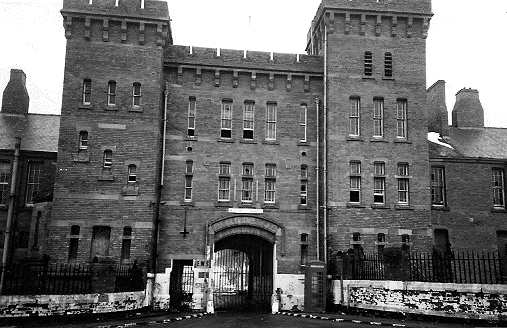
The "Keep" at Norton Barracks in January 1987 now decommissioned about to be sold to Property Developers.
As this was a Grade 2 Listed Building it was converted in to apartments.
(photo courtesy of Mark Rogers)
In 1960 1 Worcestershire Regiment returned from the West Indies to Norton Barracks and on 16th July, 1960, General Sir Richard Gale, G.C.B., K.B.E., D.S.O., M.C., Colonel of The Regiment, presented new colours to them on the Green. The Battalion remained based in Norton Barracks until they moved to Germany in 1962.
In early 1969, 14 Signal Regiment moved into Norton Barracks and remained until they disappeared under defence cuts in January 1977.
On 28th February, 1970, on the amalgamation of the Worcestershire Regiment with the Sherwood Foresters, the name of the R.H.Q. was changed to R.H.Q. The Worcestershire and Sherwood Foresters Regiment.
The R.H.Q. remained in its location, as the sole occupants of the old Barracks until 14th June, 1978, when it moved to Building 97, a brick block building on the extremity of the Western side of the new camp.
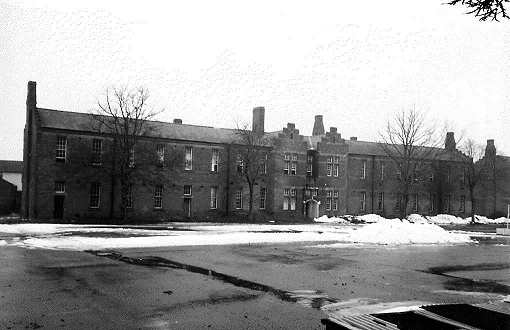
Norton Barracks in January 1987 just before they were about to be demolished
(photo courtesy of Mark Rogers)
In the 1990's the the whole site was sold off by the M.O.D. to property developers. The area immediately to the west of the old "Farrington" and "Charlemont" blocks were developed by Wainhomes as an estate of some 46 detached houses, while Persimmon Homes built a further 60 houses.
The Worcestershire Norton Sports Club now own and are retaining the cricket ground, football pitch and ranges, plus the old Depot Sergeants Mess, which is used as a Club house.
Acknowledgement to "The Worcestershire Regiment Museum".
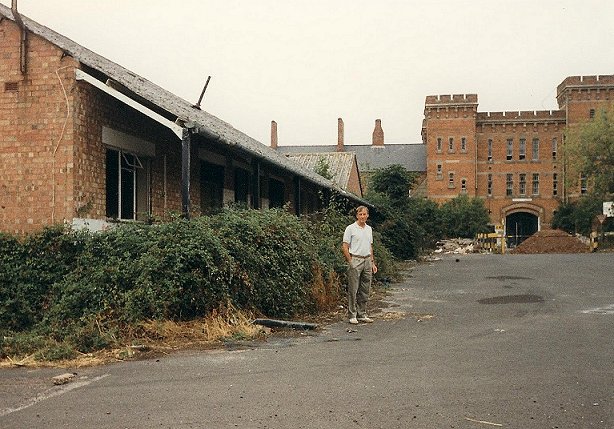
View of the "Keep" and Guardroom at Norton Barracks (1983)
photo courtesy of ex 2/Lieut. Hugh Jones (seen in photo).
Hugh spent six weeks at Norton Barrack in September 1953 as a National Service recruit in the
Royal Engineers (later of 32 Assault Engineer Regt. at Perham Down.)
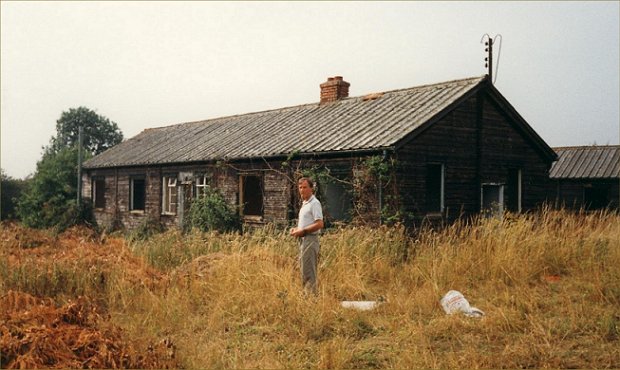
Norton Barracks huts shown here derelict prior to redeveloped of the site (1983)
photo courtesy of ex 2/Lieut. Hugh Jones (seen in photo).
Click here to view a selection of photos taken of Norton Barracks in May 1987
The photos below were taken in the Spring of 1989 by Vic Turton, grandson of Sergeant Charlie Turton who served with the 1st Battalion Worcestershire Regiment during the Boer War and World War 1.
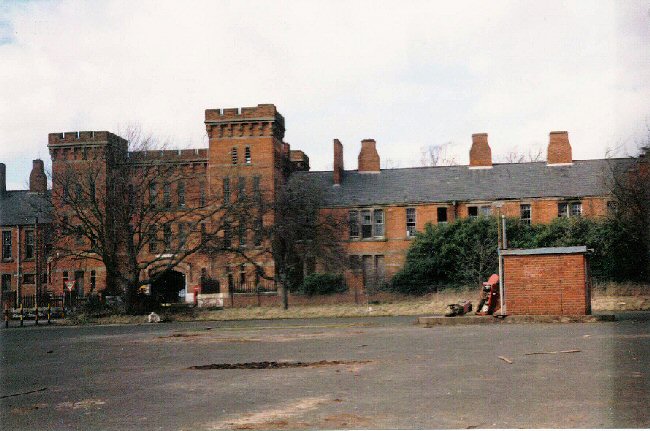
Looking towards the main entrance of the Keep from across the road
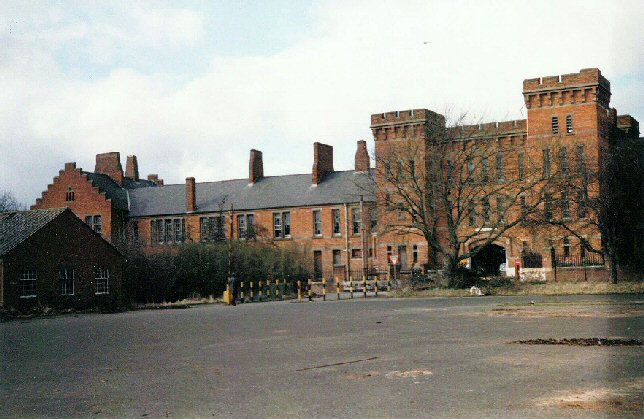
Another view looking towards the main entrance of the Keep from across the road
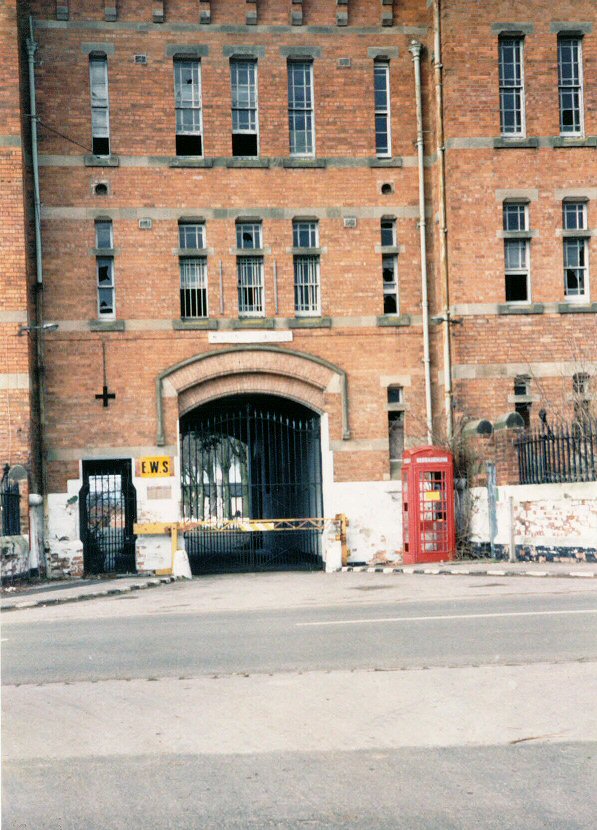
Main entrance of the Keep
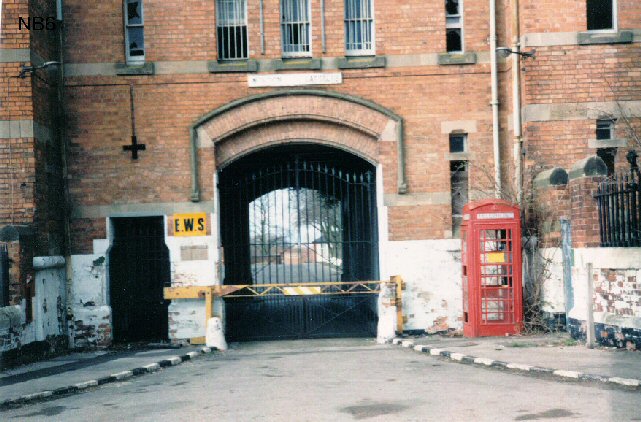
Another view of the main entrance
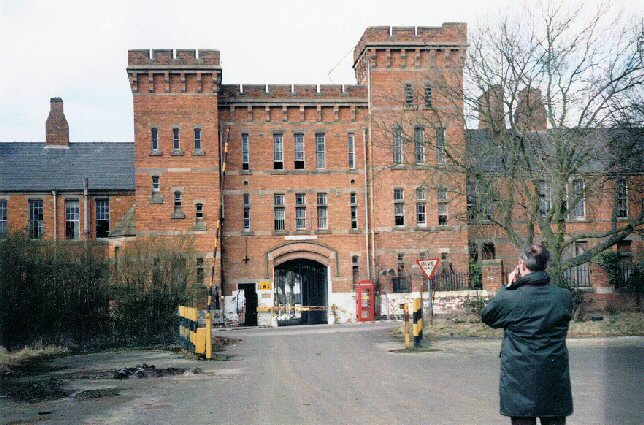
Another view of the main entrance of the Keep
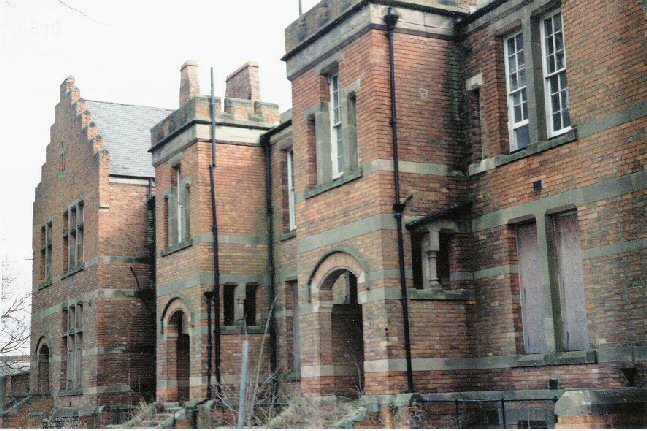
Buildings on at the rear of the Keep entrance
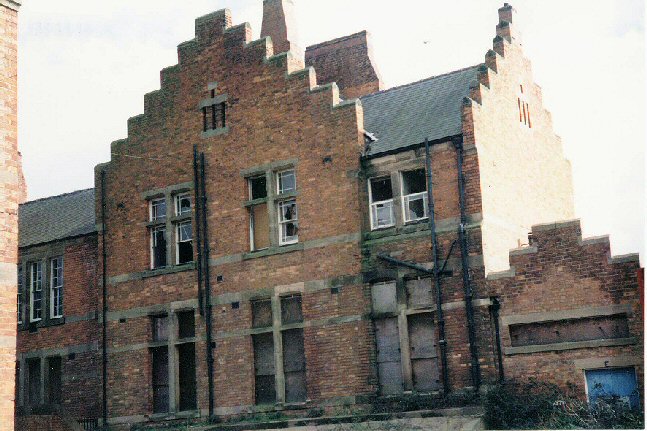
Buildings on at the rear of the Keep entrance
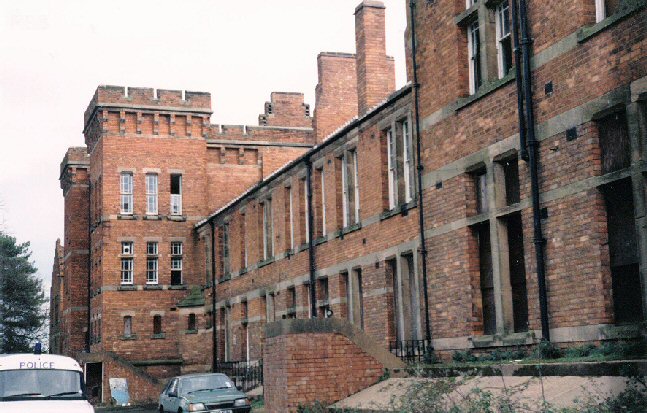
Buildings on at the rear of the Keep entrance
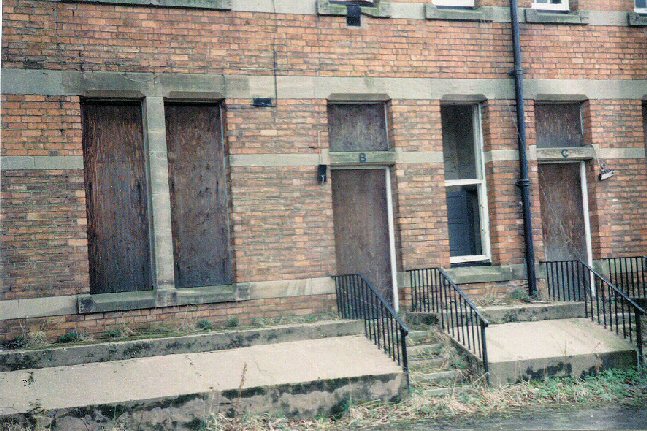
Buildings on at the rear of the Keep entrance
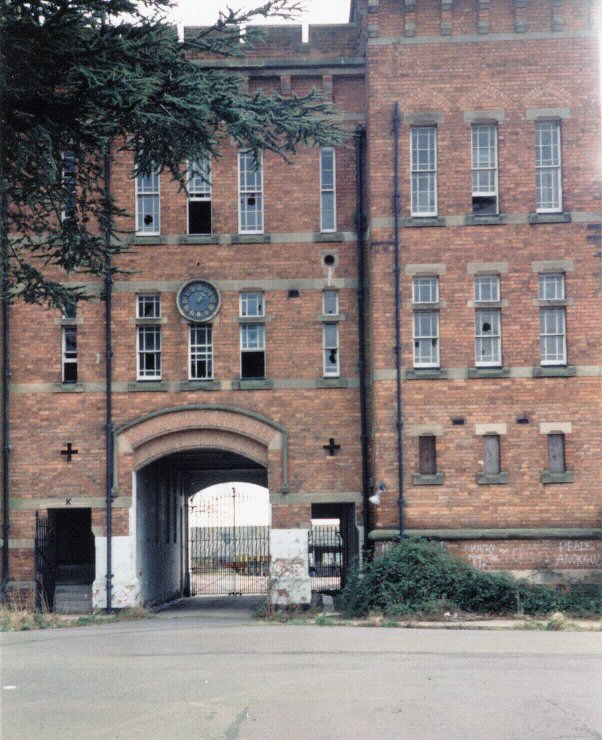
View of the rear of the Keep entrance
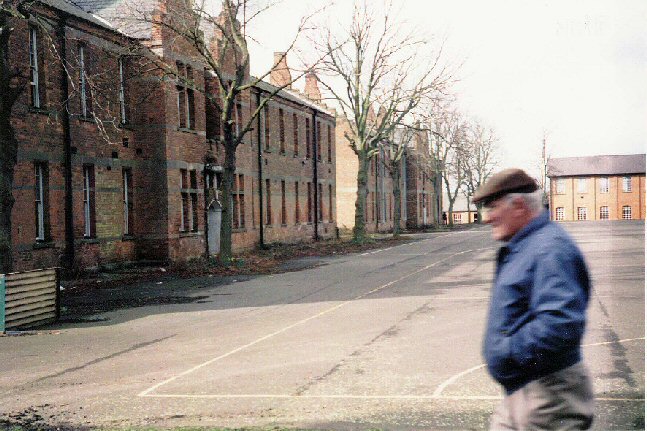
Section of the parade ground (Frank Turton in the foreground - son of Sgt. Charlie Turton)
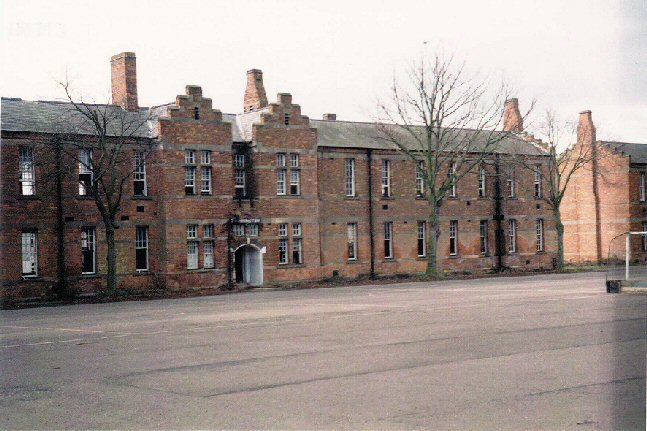
Farrington Block
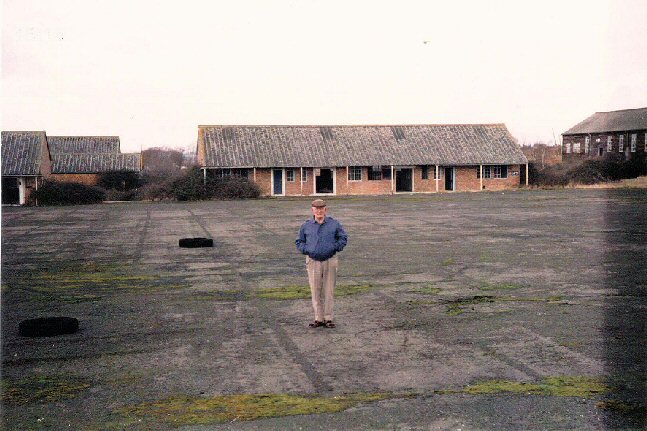
Parade ground and buildings (Frank Turton centre)
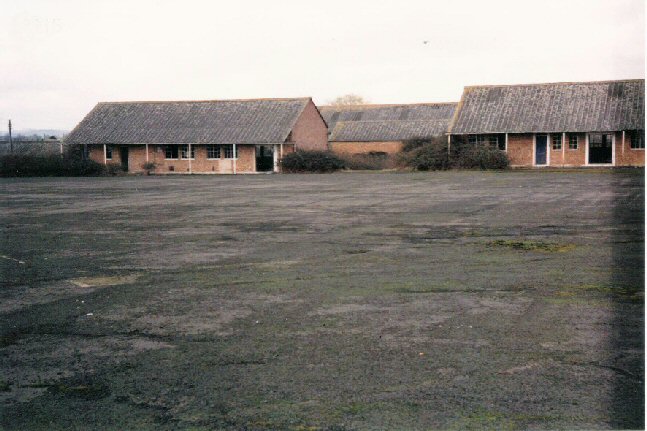
Parade ground and buildings
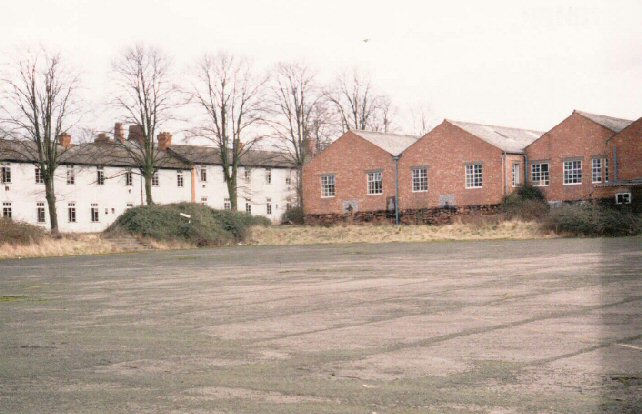
Section of parade ground and accommodation block
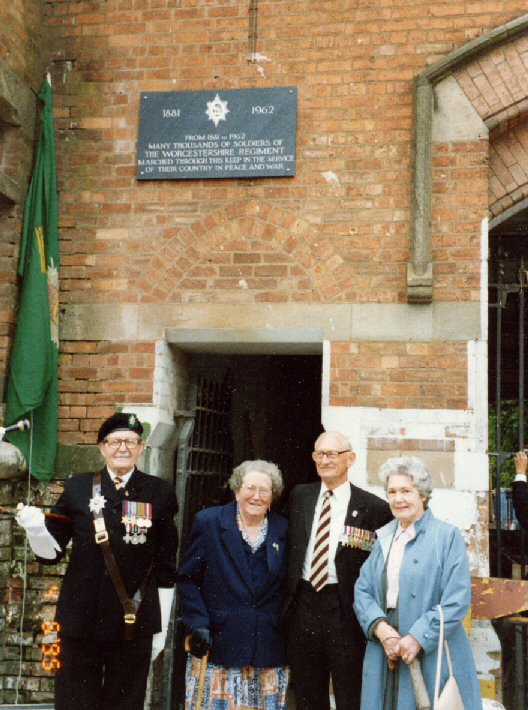
Unveiling of the 1881-1962 Plaque above the side entrance of the Keep by Colonel John Reynolds, M.C.
Left to right: Mr. & Mrs Dalloway, Colonel John Reynolds and Mrs Reynolds
(Photo supplied by Colonel John Reynolds, M.C.)
